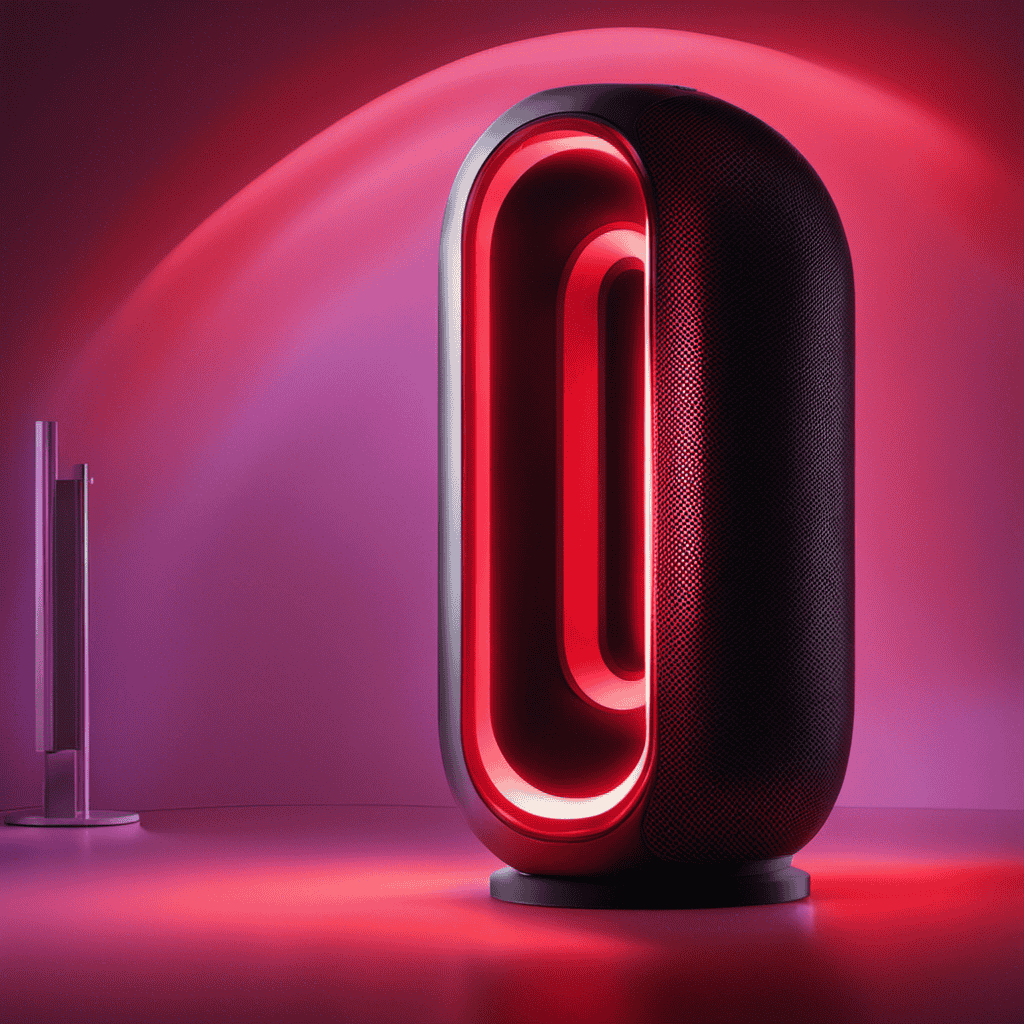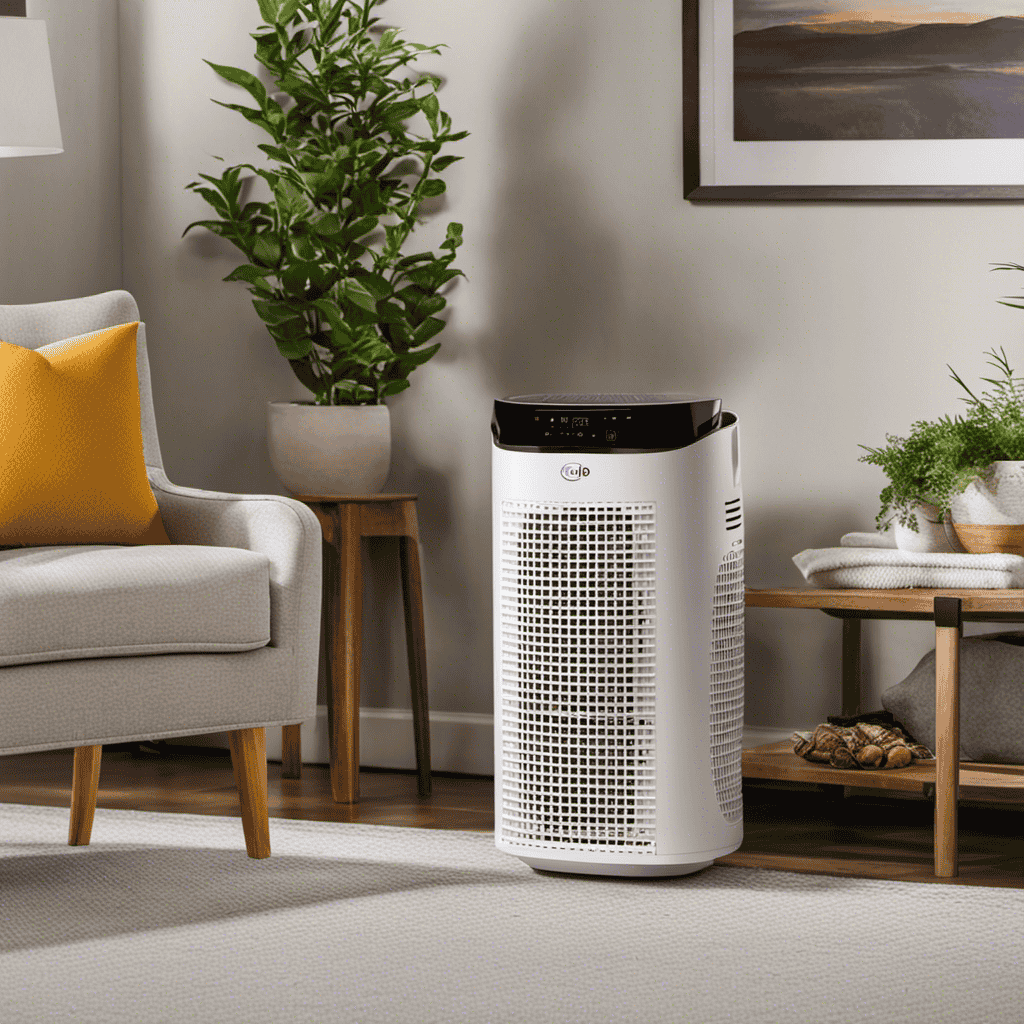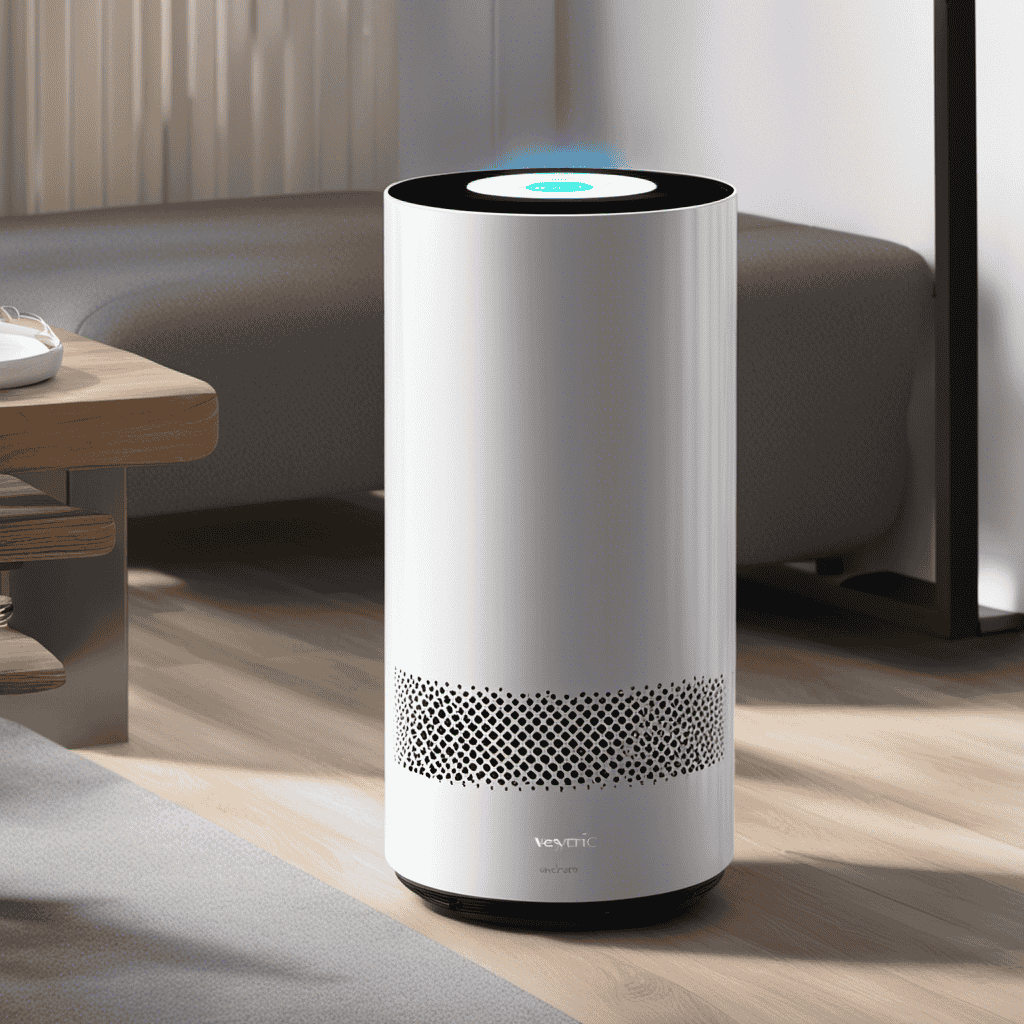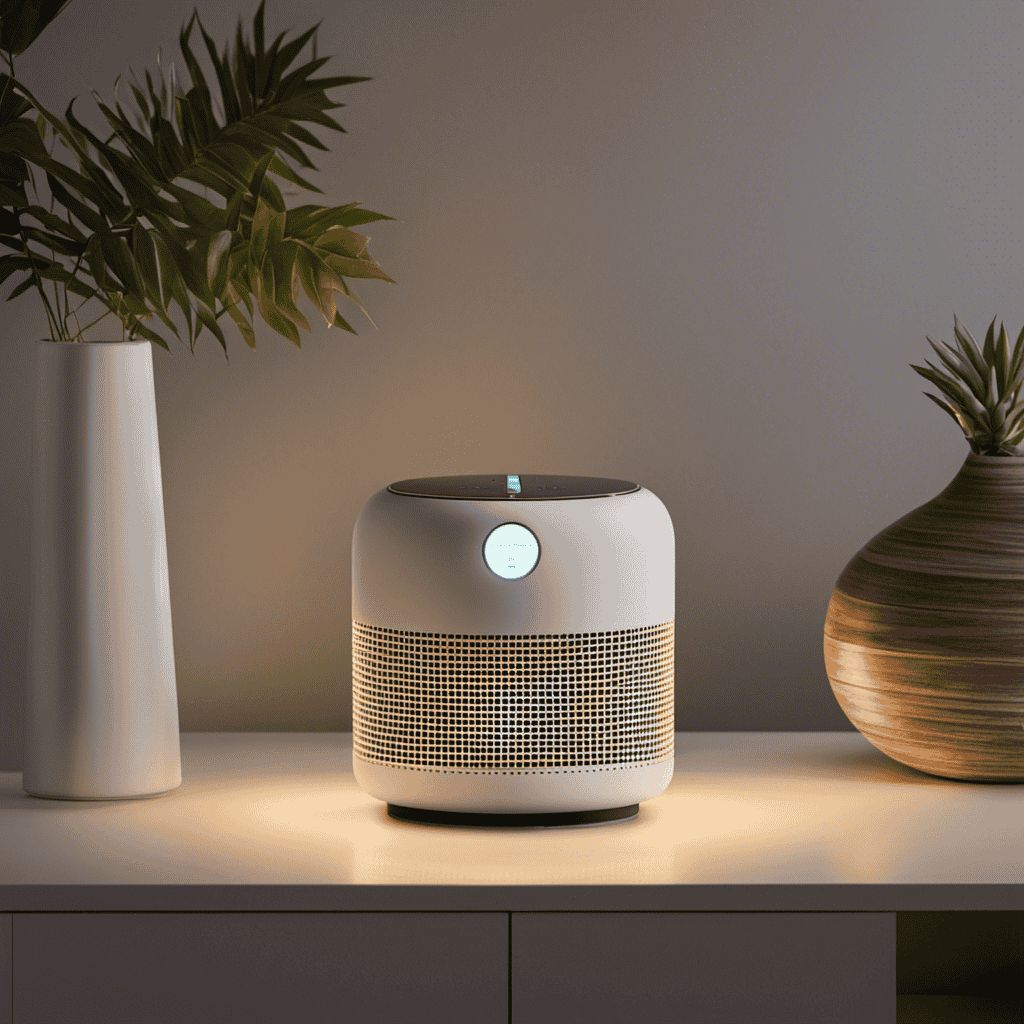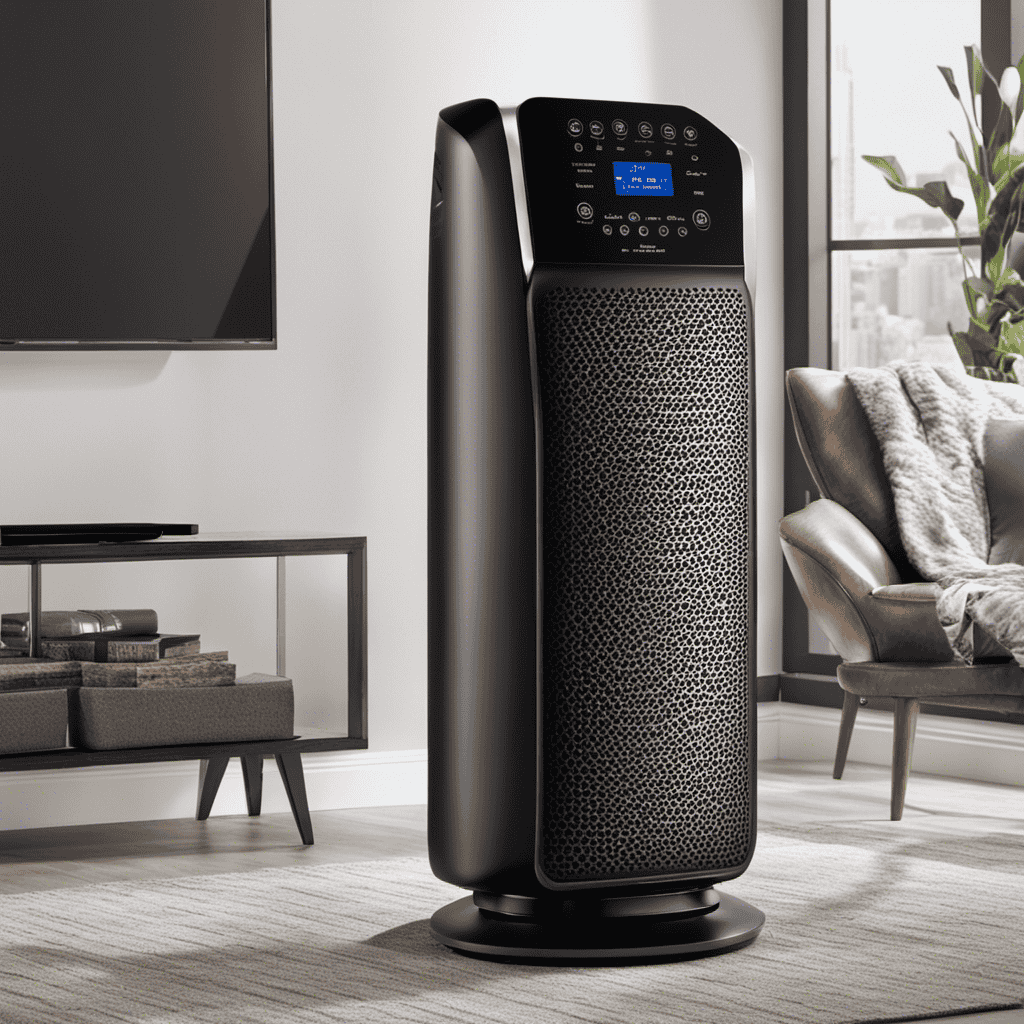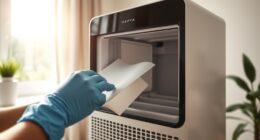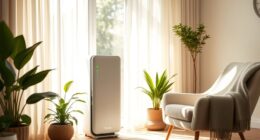I’ve observed that my Dyson air purifier is flashing red, which has made me curious about the underlying issue. In this article, we’ll explore the potential reasons behind this problem, clarify the meaning behind the indicator lights on your Dyson air purifier, and lead you through troubleshooting steps to address the issue of the red flashing light.
Additionally, I’ll provide tips for maintaining your purifier and discuss when it might be necessary to seek professional assistance.
Let’s get to the bottom of this blinking red light problem together.
Key Takeaways
- The red blinking light on a Dyson Air Purifier indicates a problem.
- Possible reasons for the red blinking indicator include filter replacement, sensor error, or power supply issues.
- Troubleshooting steps for the red blinking light issue include cleaning or replacing the filter and contacting customer support if the problem persists.
- Resetting the Dyson Air Purifier by turning it off, unplugging it, and then turning it back on can often resolve common errors.
Possible Causes of Red Blinking Light
The red blinking light on your Dyson air purifier could be caused by a few different factors.
One common cause is a clogged filter. If the filter is dirty or blocked, it can trigger the red light to blink. To fix this, you can try cleaning or replacing the filter.
Another possible cause is an issue with the power supply. Check if the power cord is properly connected and if the outlet is working. If everything seems fine, you can try resetting the air purifier by unplugging it for a few minutes and then plugging it back in.
These are some common solutions and troubleshooting steps to address the red blinking light issue. Understanding the Dyson air purifier indicator lights can help you diagnose and resolve any problems you may encounter.
Understanding the Dyson Air Purifier Indicator Lights
When it comes to the Dyson air purifier indicator lights, it’s important to understand what they mean and how to troubleshoot any issues that arise.
One common indicator light is the red blinking light, which can indicate a problem with the device.
Red Blinking Indicator
If your Dyson air purifier’s indicator is blinking red, it may indicate a problem with the device. Understanding the meaning behind the red blinking light can help troubleshoot the issue.
Here are some possible reasons for the red blinking indicator:
-
Filter Replacement: A red blinking light could mean that it’s time to replace the filter. Check the user manual for instructions on how to properly replace the filter.
-
Sensor Error: The red blinking light could also indicate a sensor error. Try resetting the device by turning it off and unplugging it for a few minutes before plugging it back in and turning it on again.
-
Power Supply Issue: Ensure that the air purifier is properly connected to a power source. Check the power cord and outlet for any issues.
-
Contact Customer Support: If the red blinking light persists after troubleshooting, it is recommended to contact Dyson customer support for further assistance.
Remember to consult the user manual for specific information regarding your Dyson air purifier model.
Troubleshooting Dyson Lights
One possible solution for troubleshooting the indicator lights on a Dyson air purifier is to reset the device. To do this, turn it off and unplug it for a few minutes. Then, plug it back in and turn it on again.
This simple troubleshooting technique can often resolve common errors with the indicator lights. However, if the lights continue to blink red after the reset, it could indicate a more serious issue with the air purifier.
In such cases, it is recommended to consult the user manual or contact Dyson customer support for further assistance. They can provide specific troubleshooting steps or arrange for repairs if necessary.
Remember to always follow safety guidelines and ensure the device is disconnected from power before attempting any troubleshooting.
Meaning of Indicator Lights
To understand the meaning of the indicator lights on your Dyson air purifier, refer to the user manual or contact Dyson customer support for assistance. However, here are some troubleshooting techniques and understanding of the symbols that may help you in the meantime:
-
Solid red light: This indicates that there is an issue with the air purifier’s functionality. Try resetting the device by unplugging it from the power source and plugging it back in after a few minutes.
-
Flashing red light: This suggests that the filter needs to be replaced. Check the user manual for instructions on how to replace the filter properly.
-
Solid blue light: This means that the air purifier is in normal operation mode and working efficiently.
-
Flashing blue light: This indicates that the air purifier is in standby mode or is currently being controlled remotely.
Troubleshooting the Red Blinking Light Issue
When your Dyson air purifier has a blinking red light, it is an indication that there is an issue with the device. One of the common causes of this issue is a clogged or dirty filter. When the filter gets filled with dirt and pollutants, it hinders the smooth functioning of the air purifier, leading to the blinking red light.
To solve this problem, you can try cleaning or replacing the filter. If the issue persists, it could be due to a faulty sensor or a more serious internal problem. In such cases, it is recommended to contact Dyson customer support for further assistance.
Now, let’s move on to the next section to learn how to reset the Dyson air purifier.
How to Reset the Dyson Air Purifier
If you’re having issues with your Dyson air purifier, a simple solution might be to reset the device. Resetting the Dyson air purifier can help resolve various problems and get it back to working efficiently.
Here are the steps to reset your Dyson air purifier:
- Turn off the air purifier and unplug it from the power source.
- Wait for at least 60 seconds to ensure a complete power cycle.
- Plug the air purifier back in and turn it on.
- Check if the blinking red light issue is resolved.
Resetting the Dyson air purifier can often help in resolving minor glitches and restoring its normal functionality. If the problem persists after resetting, it is advisable to refer to the troubleshooting steps provided by Dyson or contact their customer support for further assistance.
Common Problems With the Red Blinking Light
One common issue with the red blinking light is that it indicates a problem with the device’s power source.
When the red light error occurs, it means that the Dyson air purifier is not receiving enough power to function properly.
To troubleshoot this issue, you can start by checking if the power cord is securely plugged into both the air purifier and the power outlet. If the connection is loose, reinsert the plug firmly. Additionally, make sure that the power outlet is working correctly by plugging in another device.
If the power source is not the problem, try resetting the air purifier as mentioned in the previous subtopic. By following these troubleshooting steps, you can address the red blinking light error and potentially resolve any power-related issues.
Now, let’s explore whether the red blinking light is a warning sign.
Is the Red Blinking Light a Warning Sign
The meaning of a red blinking light on a device can vary depending on the specific device and its functions. In general, a red blinking light often indicates a warning or error condition.
When troubleshooting a blinking red light, it is important to consult the device’s manual or contact customer support for specific instructions on how to resolve the issue.
Meaning of Red Light
The red light on your Dyson air purifier means it’s time to replace the filter. Here are some troubleshooting steps to help you understand the meaning of the red light and how to resolve the issue:
-
Check the filter: The first step is to remove the filter and inspect it for any signs of wear or clogging. If the filter appears dirty or damaged, it’s time to replace it.
-
Reset the purifier: Sometimes, the red light can be triggered by a temporary glitch. Try resetting the purifier by unplugging it from the power source and plugging it back in after a few minutes.
-
Clean the sensor: The red light can also indicate that the sensor is dirty. Use a soft cloth to gently clean the sensor and see if that resolves the issue.
-
Contact customer support: If the red light persists even after following the troubleshooting steps, it’s best to reach out to Dyson customer support for further assistance.
Troubleshooting Blinking Light
If the light keeps blinking, try resetting the purifier by unplugging it and plugging it back in after a few minutes. This is one of the troubleshooting techniques you can use to resolve the red blinking light error on your Dyson air purifier.
Sometimes, the purifier may encounter a minor glitch that can be fixed by simply resetting it. If the blinking light persists after resetting, there are other troubleshooting methods you can try.
Firstly, check if the filters are properly installed and clean. A dirty or incorrectly installed filter can trigger the blinking light.
Secondly, ensure that the purifier is not placed near any obstructions or in a confined space that may restrict airflow.
Steps to Resolve the Red Blinking Light Error
To resolve the red blinking light error on your Dyson air purifier, you can try resetting the device. Here are some troubleshooting steps you can follow:
- Turn off the air purifier and unplug it from the power source.
- Wait for at least 60 seconds to allow the device to reset.
- Plug the air purifier back in and turn it on.
- Check if the red blinking light error has been resolved.
If the red blinking light error persists, it may indicate a more serious issue with the air purifier. In that case, it is recommended to contact Dyson customer support for further assistance. They can help diagnose the problem and provide solutions to get your air purifier working properly again.
Tips for Maintaining Your Dyson Air Purifier
One way you can maintain your Dyson air purifier is by regularly cleaning the filters. Cleaning the air filters is essential to ensure that your air purifier continues to function effectively and efficiently. Over time, the filters can become clogged with dust, allergens, and other particles, which can hinder the purifier’s performance. By cleaning the filters on a regular basis, you can prolong the lifespan of your air purifier and maintain its optimal performance.
To clean the filters, follow these simple steps:
| Step | Instructions |
|---|---|
| 1 | Turn off the air purifier and unplug it from the power source. |
| 2 | Remove the filters from the air purifier. |
| 3 | Gently tap the filters to remove any loose particles. |
| 4 | Rinse the filters with water to remove stubborn dirt and debris. |
Once the filters are clean, allow them to air dry completely before reinstalling them into the air purifier. Remember to clean the filters regularly to ensure that your Dyson air purifier continues to provide you with clean and fresh air.
Seeking Professional Assistance for the Red Blinking Light
When it comes to troubleshooting common issues with your Dyson air purifier, it’s important to identify the root cause before attempting any potential repair solutions.
Some common issues include a blinking red light, decreased air flow, or unusual noises.
In this discussion, we will explore various troubleshooting techniques and potential repair solutions to help you resolve these issues and ensure your Dyson air purifier is working at its best.
Troubleshooting Common Issues
If your Dyson air purifier is blinking red, you should check the filter for any clogs or debris. Here are some troubleshooting tips and common solutions that may help resolve the issue:
-
Clean the filter: Remove the filter and gently tap it to remove any loose dirt or debris. If the filter is dirty, wash it with water and let it dry completely before reinstalling.
-
Check for obstructions: Ensure that there are no obstructions blocking the airflow, such as furniture or curtains. Keep the air purifier in an open area for optimal performance.
-
Reset the purifier: Try resetting the air purifier by turning it off, unplugging it from the power source, and waiting for a few minutes before plugging it back in and turning it on again.
-
Contact customer support: If the red blinking light persists, it may indicate a more significant issue. Reach out to Dyson customer support for further assistance.
Potential Repair Solutions
To resolve the issue, you can try contacting customer support for potential repair solutions. If your Dyson air purifier is blinking red, it indicates a problem that needs attention.
Before considering repair options, you should try some troubleshooting steps to see if the issue can be resolved on your own. Here are a few things you can try:
-
Check the filter: Make sure the filter is properly installed and clean. A dirty or incorrectly placed filter can cause the red blinking light.
-
Reset the device: Sometimes, a simple reset can fix the issue. Turn off the purifier, unplug it from the power source, wait for a few minutes, and then plug it back in and turn it on.
-
Check for blockages: Ensure that there are no obstructions in the air intake or exhaust vents. Blockages can disrupt the airflow and trigger the blinking red light.
If these troubleshooting steps don’t work, it’s best to reach out to customer support for guidance on potential repair solutions. They can provide you with further assistance and recommend the appropriate steps to take.
Preventing Red Blinking Light Issues in the Future
One way to prevent future red blinking light issues is by regularly cleaning the filters on your Dyson air purifier. This simple maintenance task can help improve air quality and ensure the proper functioning of your device.
Here are four steps to effectively clean the filters:
- Turn off and unplug the air purifier to avoid any electrical accidents.
- Locate the filter compartment and remove the filters carefully.
- Use a soft brush or vacuum cleaner to remove dust and debris from the filters.
- Rinse the filters under cold water and let them dry completely before reinstalling.
Frequently Asked Questions
How Often Should I Clean the Filters in My Dyson Air Purifier to Prevent the Red Blinking Light Issue?
I clean the filters in my Dyson air purifier every 3 months to prevent the red blinking light issue. Common causes of this issue include dirty filters and a need for filter replacement.
Can the Red Blinking Light Issue Be Resolved by Simply Unplugging and Plugging Back in the Dyson Air Purifier?
Unplugging and plugging back in the Dyson air purifier may fix the red blinking light issue. However, if the problem persists, it is recommended to follow troubleshooting steps provided by Dyson for further assistance.
Is It Safe to Continue Using the Dyson Air Purifier While the Red Blinking Light Is On?
It’s not safe to use a malfunctioning air purifier with a blinking red light. Troubleshoot the issue by checking the filter, power supply, and resetting the unit. Contact customer support if the problem persists.
Will Resetting the Dyson Air Purifier Erase All of My Personalized Settings?
Resetting the Dyson air purifier will erase all personalized settings, including any troubleshooting adjustments. It’s important to consider this before proceeding with a reset to ensure you’re comfortable with starting from scratch.
Are There Any Specific Maintenance Tasks I Should Perform Regularly to Avoid the Red Blinking Light Issue?
Regular maintenance and following troubleshooting steps can help avoid the red blinking light issue. It’s important to clean the filters, check for any obstructions, and ensure proper placement.
Conclusion
In conclusion, troubleshooting the red blinking light issue with your Dyson air purifier may seem daunting at first, but with the right knowledge and steps, it can be resolved.
By understanding the indicator lights and following the reset process, you can often fix the problem yourself. However, if you’re unsure or the issue persists, it’s always wise to seek professional assistance.
Remember, regular maintenance and cleaning can help prevent red blinking light issues in the future. So don’t let that little red light scare you, tackle it head-on and breathe easy!
